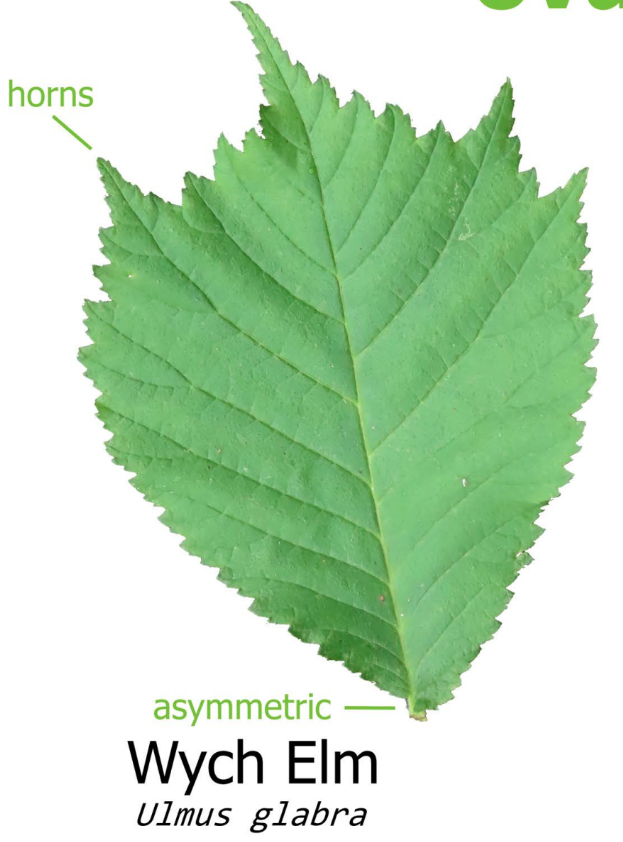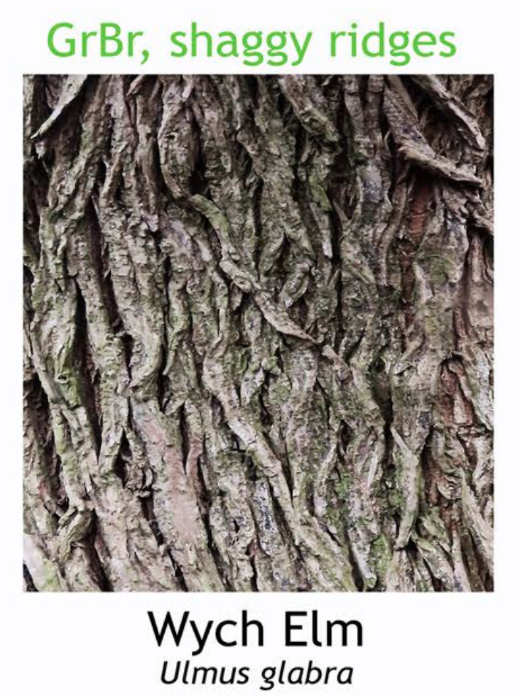A native deciduous tree species in Ireland, commonly found in woodlands, hedgerows, and along riverbanks.
Recognising the Wych Elm Tree:
-
Leaves: The leaves of the Wych Elm tree are alternate, oval to elliptical in shape, and have serrated margins. They are dark green in color and have a rough texture on the upper surface.
-
Bark: The bark of the Wych Elm tree is greyish-brown and deeply furrowed, forming irregular ridges and fissures. It may develop a mottled appearance with age, with patches of lighter and darker bark.
-
Seeds: Wych Elm trees produce small, winged seeds known as samaras, which are dispersed by the wind. The seeds are enclosed in a papery membrane and form in clusters on the branches.
-
Shape: Wych Elm trees have a broad, spreading canopy with sturdy branches and a short, thick trunk. They can grow to heights of 20-30 meters, depending on environmental conditions and growing conditions.
-
Habitat: Wych Elm trees are commonly found in woodlands, hedgerows, parks, and gardens, as well as along riverbanks and in urban areas. They prefer moist, well-drained soils and can tolerate a wide range of soil types and pH levels.



5 Interesting Facts about the Wych Elm Tree:
-
Ancient Tree: The Wych Elm tree is one of the few native elm species remaining in Europe after the devastation caused by Dutch Elm Disease in the 20th century. It has a long history in Ireland and Britain, with some specimens estimated to be several hundred years old.
-
Wildlife Habitat: Wych Elm trees provide valuable habitat and food for a variety of wildlife species. The seeds are eaten by birds and small mammals, while the foliage provides shelter and nesting sites for birds and insects.
-
Cultural Significance: Wych Elm trees have cultural and symbolic significance in Celtic and other European traditions. They have been associated with protection, strength, and resilience, and have been planted near homes, churches, and sacred sites for their perceived magical properties.
-
Wood Characteristics: The wood of the Wych Elm tree is strong, tough, and durable, making it suitable for a variety of uses, including furniture making, flooring, and boat building. It has a distinctive grain pattern and a reddish-brown colour when freshly cut, aging to a darker brown with time.
-
Landscape Value: Wych Elm trees are valued in landscaping for their attractive foliage, spreading canopy, and ornamental appearance. They are often planted in parks, gardens, and urban areas as shade trees, specimen trees, and street trees.
Uses of the Wych Elm Tree:
-
Timber Production: Wych Elm trees are sometimes harvested for timber production. The wood is strong, tough, and durable, making it suitable for a variety of uses, including furniture making, flooring, and boat building.
-
Wildlife Habitat: Wych Elm trees provide valuable habitat and food for a variety of wildlife species. The seeds are eaten by birds and small mammals, while the foliage provides shelter and nesting sites for birds and insects.
-
Landscaping: Wych Elm trees are valued in landscaping for their attractive foliage, spreading canopy, and ornamental appearance. They are often planted in parks, gardens, and urban areas as shade trees, specimen trees, and street trees.
Contribution to Biodiversity:
-
Habitat Provider: Wych Elm trees contribute to biodiversity by providing habitat and food for a variety of wildlife species in woodlands, hedgerows, parks, and urban areas. Their seeds are eaten by birds and small mammals, while their foliage provides shelter and nesting sites for birds and insects.
-
Genetic Diversity: Wych Elm trees are important for maintaining genetic diversity within elm populations. They have adapted to a range of environmental conditions and provide valuable genetic resources for breeding programs and conservation efforts aimed at preserving native elm species.
-
Erosion Control: Wych Elm trees help stabilise soil and prevent erosion in woodlands, hedgerows, and along riverbanks. Their extensive root systems help bind soil particles together and reduce the impact of water flow, contributing to the health and stability of ecosystems.
In summary, the Wych Elm tree is recognisable by its broad, spreading canopy, rough bark, oval leaves, and winged seeds. It holds cultural significance, provides valuable resources for wildlife, and contributes to biodiversity and ecosystem health in Ireland's woodlands, hedgerows, parks, and urban areas. Additionally, it serves as a timber resource, landscape tree, and erosion control measure, supporting diverse populations of wildlife and enhancing ecosystem resilience in natural and urban landscapes.
Images taken from the beautiful posters created by Phil Barnett and you can download these and/or purchase other great designs from his online shop.
